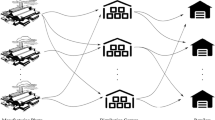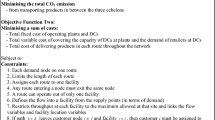Abstract
In this study, we formulate and analyze a strategic design model for three-echelon distribution systems with two-level routing considerations. The key design decisions considered are: the number and locations of distribution centers (DC’s), which big clients (clients with larger demand) should be included in the first level routing (the routing between plants and DC’s), the first-level routing between plants, DC’s and big clients, and the second-level routing between DC’s and other clients not included in the first-level routing. A hybrid genetic algorithm embedded with a routing heuristic is developed to efficiently find near-optimal solutions. The quality of the solution to a series of small test problems is evaluated—by comparison with the optimal solution solved using LINGO 9.0. In test problems for which exact solutions are available, the heuristic solution is within 1% of optimal. At last, the model is applied to design a national finished goods distribution system for a Taiwan label-stock manufacturer. Through the case study, we find that the inclusion of big clients in the first-level routing in the analysis leads to a better network design in terms of total logistic costs.
Similar content being viewed by others

References
Albareda-Sambola, M., Díaz, J. A., & Fernández, E. (2005). A compact model and tight bounds for a combined location-routing problem. Computers and Operations Research, 32, 407–428.
Ambrosino, D., & Scutellá, M. G. (2005). Distribution network design: new problems and related models. European Journal of Operational Research, 165, 610–624.
Balakrishnan, A., Ward, J. E., & Wang, R. T. (1987). Integrated facility location and vehicle routing models: recent work and future prospects. American Journal of Mathematical and Management Science, 75, 35–61.
Bodin, L., Golden, B. L., Assad, A., & Ball, M. (1983). Routing and scheduling of vehicles and crews. Computers & Operations Research, 10(2), 63–211.
Bookbinder, J. H., & Reece, K. E. (1988). Vehicle routing considerations in distribution system design. European Journal of Operational Research, 37(2), 204–213.
Caballero, R., González, M., Guerrero, F. M., Molina, J., & Paralera, C. (2007). Solving a multiobjective location routing problem with a metaheuristic based on tabu search. Application to a real case in Andalusia. European Journal of Operational Research, 177(3), 1751–1763.
Clarke, G., & Wright, J. W. (1964). Scheduling of vehicles from a central depot to a number of delivery points. Operations Research, 12(4), 568–581.
Gavish, B., & Graves, S. C. (1978). The traveling Salesman problem and related problems. Working paper, Massachusetts Institute of Technology.
Goldberg, D. E. (1989). Genetic algorithms in searching, optimization & machine learning. Reading: Addison-Wesley.
Hansen, P. H., Hegedahl, B., Hjortkjaer, S., & Obel, B. (1994). Heuristic solution to the warehouse location-routing problem. European Journal of Operational Research, 76(1), 111–127.
Holland, J. H. (1975). Adaptation in neural and artificial systems. Ann Arbor: Univ. Michigan Press.
Jacobsen, S. K., & Madsen, O. B. G. (1980). A comparative study of heuristics for a two-level routing-location problem. European Journal of Operational Research, 5, 378–387.
Laporte, G., Nobert, Y., & Taillefer, S. (1988). Solving a family of multi-depot vehicle routing and location-routing problems. Transportation Science, 22(3), 161–172.
Madsen, O. B. G. (1983). Methods for solving combined two level location-routing problems of realistic dimensions. European Journal of Operational Research, 12, 295–301.
Melechovský, J., Prins, C., & Calvo, R. W. (2005). A metaheuristic to solve a location-routing problem with non-linear costs. Journal of Heuristics, 11, 375–391.
Min, H., Jayaraman, V., & Srivastava, R. (1998). Combined location-routing problems: a synthesis and future research directions. European Journal of Operational Research, 108, 1–15.
Nagy, G., & Salhi, S. (2007). Location-routing: issues, models and methods. European Journal of Operational Research, 177, 649–672.
Or, I., & Pierskalla, W. P. (1979). Transportation location-allocation model for regional blood banking. AIIE Transactions, 11(2), 86–95.
Perl, J., & Daskin, M. S. (1985). A Warehouse location-routing problem. Transportation Research, Part B: Methodological, 19 B(5), 381–396.
Prins, C., Prodhon, C., & Calvo, R. W. (2006a). Solving the capacitated location-routing problem by a GRASP complemented by a learning process and a path relinking. 4OR-A Quarterly Journal of Operations Research, 4(3), 221–238.
Prins, C., Prodhon, C., & Calvo, R. W. (2006b). A memetic algorithm with population management (MA|PM) for the capacitated location-routing problem. In: Lecture notes in computer science (vol. 3906, pp. 183–194). Berlin: Springer.
Prins, C., Prodhon, C., Ruiz, A., Soriano, P., & Calvo, R. W. (2007). Solving the capacitated location-routing problem by a cooperative Lagrangian relaxation-granular tabu search heuristic. Transportation Science, 41(4), 470–483.
Prodhon, C. (2009). http://prodhonc.free.fr/homepage.
Salhi, S., & Rand, G. K. (1989). The effect of ignoring routes when locating depots. European Journal of Operational Research, 39, 150–156.
Srivastava, R., & Benton, W. C. (1990). The location-routing problem: considerations in physical distribution system design. Computers and Operations Research, 17, 427–435.
Tuzun, D., & Burke, L. I. (1999). Two-phase tabu search approach to the location routing problem. European Journal of Operational Research, 116(1), 87–99.
Wasner, M., & Zäpfel, G. (2004). An integrated multi-depot hub-location vehicle routing model for network planning of parcel service. International Journal of Production Economics, 90(3), 403–419.
Wu, T.-H., Low, C., & Bai, J.-W. (2002). Heuristic solutions to multi-depot location-routing problems. Computers and Operations Research, 29(10), 1393–1415.
Author information
Authors and Affiliations
Corresponding author
Rights and permissions
About this article
Cite this article
Lin, JR., Lei, HC. Distribution systems design with two-level routing considerations. Ann Oper Res 172, 329–347 (2009). https://doi.org/10.1007/s10479-009-0628-y
Published:
Issue Date:
DOI: https://doi.org/10.1007/s10479-009-0628-y



